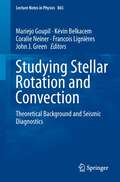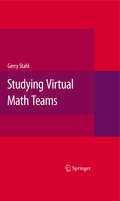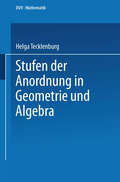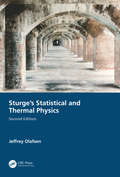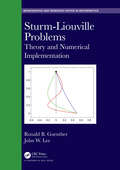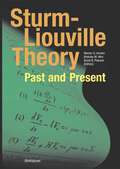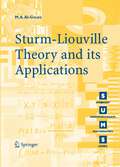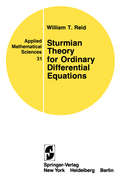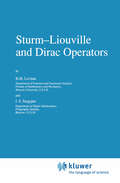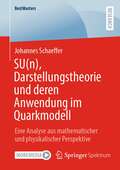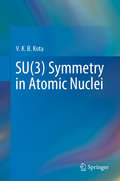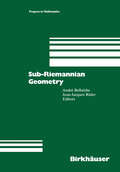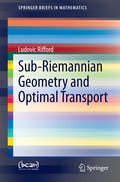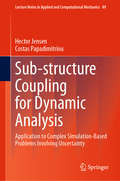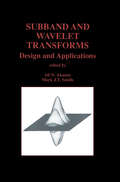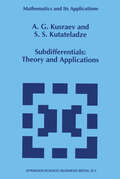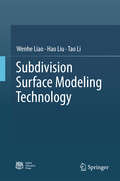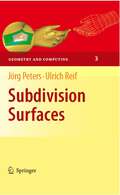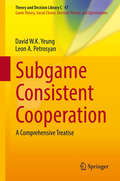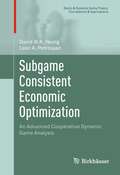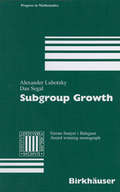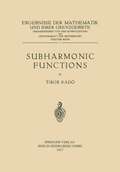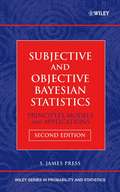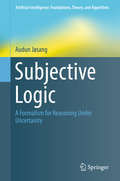- Table View
- List View
Studying Stellar Rotation and Convection: Theoretical Background and Seismic Diagnostics (Lecture Notes in Physics #865)
by Mariejo Goupil, Kévin Belkacem, Coralie Neiner, Francois Lignières and John J. GreenThis volume synthesizes the results of work carried out by several international teams of the SIROCO (Seismology for Rotation and Convection) collaboration. It provides the theoretical background required to interpret the huge quantity of high-quality observational data recently provided by space experiments such as CoRoT and Kepler. Asteroseismology allows astrophysicists to test, to model and to understand stellar structure and evolution as never before. The chapters in this book address the two groups of topics summarized as "Stellar Rotation and Associated Seismology" as well as "Stellar Convection and Associated Seismology". The book offers the reader solid theoretical background knowledge and adapted seismic diagnostic techniques.
Studying Virtual Math Teams (Computer-Supported Collaborative Learning Series #11)
by Gerry StahlStudying Virtual Math Teams centers on detailed empirical studies of how students in small online groups make sense of math issues and how they solve problems by making meaning together. These studies are woven together with materials that describe the online environment and pedagogical orientation, as well as reflections on the theoretical implications of the findings in the studies. The nature of group cognition and shared meaning making in collaborative learning is a foundational research issue in CSCL. More generally, the theme of sense making is a central topic in information science. While many authors allude to these topics, few have provided this kind of detailed analysis of the mechanisms of intersubjective meaning making. This book presents a coherent research agenda that has been pursued by the author and his research group. The book opens with descriptions of the project and its methodology, as well as situating this research in the past and present context of the CSCL research field. The core research team then presents five concrete analyses of group interactions in different phases of the Virtual Math Teams research project. These chapters are followed by several studies by international collaborators, discussing the group discourse, the software affordances and alternative representations of the interaction, all using data from the VMT project. The concluding chapters address implications for the theory of group cognition and for the methodology of the learning sciences. In addition to substantial introductory and concluding chapters, this important new book includes analyses based upon the author's previous research, thereby providing smooth continuity and an engaging flow that follows the progression of the research. The VMT project has dual goals: (a) to provide a source of experience and data for practical and theoretical explorations of group knowledge building and (b) to develop an effective online environment and educational service for collaborative learning of mathematics. Studying Virtual Math Teams reflects these twin orientations, reviewing the intertwined aims and development of a rigorous science of small-group cognition and a Web 2.0 educational math service. It documents the kinds of interactional methods that small groups use to explore math issues and provides a glimpse into the potential of online interaction to promote productive math discourse.
Sturge's Statistical and Thermal Physics, Second Edition
by Jeffrey OlafsenThe original work by M.D. Sturge has been updated and expanded to include new chapters covering non-equilibrium and biological systems. This second edition re-organizes the material in a more natural manner into four parts that continues to assume no previous knowledge of thermodynamics. The four divisions of the material introduce the subject inductively and rigorously, beginning with key concepts of equilibrium thermodynamics such as heat, temperature and entropy. The second division focuses on the fundamentals of modern thermodynamics: free energy, chemical potential and the partition function. The second half of the book is then designed with the flexibility to meet the needs of both the instructor and the students, with a third section focused on the different types of gases: ideal, Fermi-Dirac, Bose-Einstein, Black Body Radiation and the Photon gases. In the fourth and final division of the book, modern thermostatistical applications are addressed: semiconductors, phase transitions, transport processes, and finally the new chapters on non-equilibrium and biological systems. Key Features: Provides the most readable, thorough introduction to statistical physics and thermodynamics, with magnetic, atomic, and electrical systems addressed alongside development of fundamental topics at a non-rigorous mathematical level Includes brand-new chapters on biological and chemical systems and non-equilibrium thermodynamics, as well as extensive new examples from soft condensed matter and correction of typos from the prior edition Incorporates new numerical and simulation exercises throughout the book Adds more worked examples, problems, and exercises
Sturge's Statistical and Thermal Physics, Second Edition
by Jeffrey OlafsenThe original work by M.D. Sturge has been updated and expanded to include new chapters covering non-equilibrium and biological systems. This second edition re-organizes the material in a more natural manner into four parts that continues to assume no previous knowledge of thermodynamics. The four divisions of the material introduce the subject inductively and rigorously, beginning with key concepts of equilibrium thermodynamics such as heat, temperature and entropy. The second division focuses on the fundamentals of modern thermodynamics: free energy, chemical potential and the partition function. The second half of the book is then designed with the flexibility to meet the needs of both the instructor and the students, with a third section focused on the different types of gases: ideal, Fermi-Dirac, Bose-Einstein, Black Body Radiation and the Photon gases. In the fourth and final division of the book, modern thermostatistical applications are addressed: semiconductors, phase transitions, transport processes, and finally the new chapters on non-equilibrium and biological systems. Key Features: Provides the most readable, thorough introduction to statistical physics and thermodynamics, with magnetic, atomic, and electrical systems addressed alongside development of fundamental topics at a non-rigorous mathematical level Includes brand-new chapters on biological and chemical systems and non-equilibrium thermodynamics, as well as extensive new examples from soft condensed matter and correction of typos from the prior edition Incorporates new numerical and simulation exercises throughout the book Adds more worked examples, problems, and exercises
Sturm-Liouville Problems: Theory and Numerical Implementation (Chapman & Hall/CRC Monographs and Research Notes in Mathematics)
by Ronald B. Guenther John W LeeSturm-Liouville problems arise naturally in solving technical problems in engineering, physics, and more recently in biology and the social sciences. These problems lead to eigenvalue problems for ordinary and partial differential equations. Sturm-Liouville Problems: Theory and Numerical Implementation addresses, in a unified way, the key issues that must be faced in science and engineering applications when separation of variables, variational methods, or other considerations lead to Sturm-Liouville eigenvalue problems and boundary value problems.
Sturm-Liouville Theory: Past and Present
by Werner O. Amrein Andreas M. Hinz David B. PearsonThis is a collection of survey articles based on lectures presented at a colloquium and workshop in Geneva in 2003 to commemorate the 200th anniversary of the birth of Charles François Sturm. It aims at giving an overview of the development of Sturm-Liouville theory from its historical roots to present day research. It is the first time that such a comprehensive survey has been made available in compact form. The contributions come from internationally renowned experts and cover a wide range of developments of the theory. The book can therefore serve both as an introduction to Sturm-Liouville theory and as background for ongoing research. The volume is addressed to researchers in related areas, to advanced students and to those interested in the historical development of mathematics. The book will also be of interest to those involved in applications of the theory to diverse areas such as engineering, fluid dynamics and computational spectral analysis.
Sturm-Liouville Theory and its Applications (Springer Undergraduate Mathematics Series)
by Mohammed Al-GwaizDeveloped from a course taught to senior undergraduates, this book provides a unified introduction to Fourier analysis and special functions based on the Sturm-Liouville theory in L2. The text’s presentation follows a clear, rigorous mathematical style that is highly readable. The author first establishes the basic results of Sturm-Liouville theory and then provides examples and applications to illustrate the theory. The final two chapters, on Fourier and Laplace transformations, demonstrate the use of the Fourier series method for representing functions to integral representations.
Sturmian Theory for Ordinary Differential Equations (Applied Mathematical Sciences #31)
by William T. ReidSU: Eine Analyse aus mathematischer und physikalischer Perspektive (BestMasters)
by Johannes SchaefferJohannes Schaeffer liefert eine interdisziplinäre, gruppentheoretische Analyse des Quarkmodells. Hierbei wird im ersten Teil eine solide, mathematisch präzise Grundlage der Darstellungstheorie der Gruppe SU(n) geschaffen, welche im zweiten Teil auf die Phänomenologie der Hadronen angewendet wird. Der Autor bietet durch diese Gratwanderung zwischen mathematischer Betrachtung und physikalischer Anwendung Studierenden beider Fächer die Möglichkeit, sich gewinnbringend mit der Thematik auseinanderzusetzen.Der AutorJohannes Schaeffer ist nach seinem Studium der Mathematik und Physik an der Johannes Gutenberg-Universität Mainz derzeit als Studienreferendar am Studienseminar für das Lehramt an Gymnasien in Mainz tätig.
SU(3) Symmetry in Atomic Nuclei
by V. K. KotaThis book provides an understandable review of SU(3) representations, SU(3) Wigner–Racah algebra and the SU(3) ⊃ SO(3) integrity basis operators, which are often considered to be difficult and are avoided by most nuclear physicists. Explaining group algebras that apply to specific physical systems and discussing their physical applications, the book is a useful resource for researchers in nuclear physics. At the same time it helps experimentalists to interpret data on rotational nuclei by using SU(3) symmetry that appears in a variety of nuclear models, such as the shell model, pseudo-SU(3) model, proxy-SU(3) model, symplectic Sp(6, R) model, various interacting boson models, various interacting boson–fermion models, and cluster models. In addition to presenting the results from all these models, the book also describes a variety of statistical results that follow from the SU(3) symmetry.
Sub-Riemannian Geometry and Optimal Transport (SpringerBriefs in Mathematics)
by Ludovic RiffordThe book provides an introduction to sub-Riemannian geometry and optimal transport and presents some of the recent progress in these two fields. The text is completely self-contained: the linear discussion, containing all the proofs of the stated results, leads the reader step by step from the notion of distribution at the very beginning to the existence of optimal transport maps for Lipschitz sub-Riemannian structure. The combination of geometry presented from an analytic point of view and of optimal transport, makes the book interesting for a very large community. This set of notes grew from a series of lectures given by the author during a CIMPA school in Beirut, Lebanon.
Sub-structure Coupling for Dynamic Analysis: Application to Complex Simulation-Based Problems Involving Uncertainty (Lecture Notes in Applied and Computational Mechanics #89)
by Costas Papadimitriou Hector JensenThis book combines a model reduction technique with an efficient parametrization scheme for the purpose of solving a class of complex and computationally expensive simulation-based problems involving finite element models. These problems, which have a wide range of important applications in several engineering fields, include reliability analysis, structural dynamic simulation, sensitivity analysis, reliability-based design optimization, Bayesian model validation, uncertainty quantification and propagation, etc. The solution of this type of problems requires a large number of dynamic re-analyses. To cope with this difficulty, a model reduction technique known as substructure coupling for dynamic analysis is considered. While the use of reduced order models alleviates part of the computational effort, their repetitive generation during the simulation processes can be computational expensive due to the substantial computational overhead that arises at the substructure level. In this regard, an efficient finite element model parametrization scheme is considered. When the division of the structural model is guided by such a parametrization scheme, the generation of a small number of reduced order models is sufficient to run the large number of dynamic re-analyses. Thus, a drastic reduction in computational effort is achieved without compromising the accuracy of the results. The capabilities of the developed procedures are demonstrated in a number of simulation-based problems involving uncertainty.
Subband and Wavelet Transforms: Design and Applications (The Springer International Series in Engineering and Computer Science #340)
by Ali N. Akansu Mark J. T. SmithThe scientists and engineers of today are relentless in their continuing study and analysis of the world about us from the microcosm to the macrocosm. A central purpose of this study is to gain sufficient scientific information and insight to enable the development of both representative and useful models of the superabundance of physical processes that surround us. The engineers need these models and the associated insight in order to build the information processing systems and control systems that comprise these new and emerging technologies. Much of the early modeling work that has been done on these systems has been based on the linear time-invariant system theory and its extensive use of Fourier transform theory for both continuous and discrete systems and signals. However many of the signals arising in nature and real systems are neither stationary nor linear but tend to be concentrated in both time and frequency. Hence a new methodology is needed to take these factors properly into account.
Subdifferentials: Theory and Applications (Mathematics and Its Applications #323)
by A.G. Kusraev Semën Samsonovich KutateladzeThe subject of the present book is sub differential calculus. The main source of this branch of functional analysis is the theory of extremal problems. For a start, we explicate the origin and statement of the principal problems of sub differential calculus. To this end, consider an abstract minimization problem formulated as follows: x E X, f(x) --+ inf. Here X is a vector space and f : X --+ iR is a numeric function taking possibly infinite values. In these circumstances, we are usually interested in the quantity inf f( x), the value of the problem, and in a solution or an optimum plan of the problem (i. e. , such an x that f(x) = inf f(X», if the latter exists. It is a rare occurrence to solve an arbitrary problem explicitly, i. e. to exhibit the value of the problem and one of its solutions. In this respect it becomes necessary to simplify the initial problem by reducing it to somewhat more manageable modifications formulated with the details of the structure of the objective function taken in due account. The conventional hypothesis presumed in attempts at theoretically approaching the reduction sought is as follows. Introducing an auxiliary function 1, one considers the next problem: x EX, f(x) -l(x) --+ inf. Furthermore, the new problem is assumed to be as complicated as the initial prob lem provided that 1 is a linear functional over X, i. e.
Subdivision Surface Modeling Technology
by Wenhe Liao Hao Liu Tao LiThis book offers a comprehensive introduction to Subdivision Surface Modeling Technology focusing not only on fundamental theories but also on practical applications. It furthers readers’ understanding of the contacts between spline surfaces and subdivision surfaces, enabling them to master the Subdivision Surface Modeling Technology for analyzing subdivision surfaces. Subdivision surface modeling is a popular technology in the field of computer aided design (CAD) and computer graphics (CG) thanks to its ability to model meshes of any topology. The book also discusses some typical Subdivision Surface Modeling Technologies, such as interpolation, fitting, fairing, intersection, as well as trimming and interactive editing. It is a valuable tool, enabling readers to grasp the main technologies of subdivision surface modeling and use them in software development, which in turn leads to a better understanding of CAD/CG software operations.
Subdivision Surfaces (Geometry and Computing #3)
by Jörg Peters Ulrich ReifSince their first appearance in 1974, subdivision algorithms for generating surfaces of arbitrary topology have gained widespread popularity in computer graphics and are being evaluated in engineering applications. This development was complemented by ongoing efforts to develop appropriate mathematical tools for a thorough analysis, and today, many of the fascinating properties of subdivision are well understood. This book summarizes the current knowledge on the subject. It contains both meanwhile classical results as well as brand-new, unpublished material, such as a new framework for constructing C^2-algorithms. The focus of the book is on the development of a comprehensive mathematical theory, and less on algorithmic aspects. It is intended to serve researchers and engineers - both new to the beauty of the subject - as well as experts, academic teachers and graduate students or, in short, anybody who is interested in the foundations of this flourishing branch of applied geometry.
Subgame Consistent Cooperation: A Comprehensive Treatise (Theory and Decision Library C #47)
by David W.K. Yeung Leon A. PetrosyanStrategic behavior in the human and social world has been increasingly recognized in theory and practice. It is well known that non-cooperative behavior could lead to suboptimal or even highly undesirable outcomes. Cooperation suggests the possibility of obtaining socially optimal solutions and the calls for cooperation are prevalent in real-life problems. Dynamic cooperation cannot be sustainable if there is no guarantee that the agreed upon optimality principle at the beginning is maintained throughout the cooperation duration. It is due to the lack of this kind of guarantees that cooperative schemes fail to last till its end or even fail to get started. The property of subgame consistency in cooperative dynamic games and the corresponding solution mechanism resolve this “classic” problem in game theory. This book is a comprehensive treatise on subgame consistent dynamic cooperation covering the up-to-date state of the art analyses in this important topic. It sets out to provide the theory, solution techniques and applications of subgame consistent cooperation in a wide spectrum of paradigms for analysis which includes cooperative dynamic game models with stochastic state dynamics, with uncertain future payoffs, with asynchronous players’ horizons, with random cooperation duration, with control spaces switching and with transferable and nontransferable payoffs. The book would be a significant research reference text for researchers in game theory, economists, applied mathematicians, policy-makers, corporate decision-makers, and graduate students in applied mathematics, game theory, decision sciences, economics and management sciences.
Subgame Consistent Economic Optimization: An Advanced Cooperative Dynamic Game Analysis (Static & Dynamic Game Theory: Foundations & Applications)
by David W.K. Yeung Leon A. PetrosyanVarious imperfections in existing market systems prevent the free market from serving as a truly efficient allocation mechanism, but optimization of economic activities provides an effective remedial measure. Cooperative optimization claims that socially optimal and individually rational solutions to decision problems involving strategic action over time exist. To ensure that cooperation will last throughout the agreement period, however, the stringent condition of subgame consistency is required.This textbook presents a study of subgame consistent economic optimization, developing game-theoretic optimization techniques to establish the foundation for an effective policy menu to tackle the suboptimal behavior that the conventional market mechanism fails to resolve.
Subgroup Growth (Progress in Mathematics #212)
by Alexander Lubotzky Dan SegalAward-winning monograph of the Ferran Sunyer i Balaguer Prize 2001. Subgroup growth studies the distribution of subgroups of finite index in a group as a function of the index. In the last two decades this topic has developed into one of the most active areas of research in infinite group theory; this book is a systematic and comprehensive account of the substantial theory which has emerged.As well as determining the range of possible 'growth types', for finitely generated groups in general and for groups in particular classes such as linear groups, a main focus of the book is on the tight connection between the subgroup growth of a group and its algebraic structure. A wide range of mathematical disciplines play a significant role in this work: as well as various aspects of infinite group theory, these include finite simple groups and permutation groups, profinite groups, arithmetic groups and Strong Approximation, algebraic and analytic number theory, probability, and p-adic model theory. Relevant aspects of such topics are explained in self-contained 'windows'.
Subharmonic Functions (Ergebnisse der Mathematik und Ihrer Grenzgebiete. 1. Folge #5, 1)
by Tibor RadóDieser Buchtitel ist Teil des Digitalisierungsprojekts Springer Book Archives mit Publikationen, die seit den Anfängen des Verlags von 1842 erschienen sind. Der Verlag stellt mit diesem Archiv Quellen für die historische wie auch die disziplingeschichtliche Forschung zur Verfügung, die jeweils im historischen Kontext betrachtet werden müssen. Dieser Titel erschien in der Zeit vor 1945 und wird daher in seiner zeittypischen politisch-ideologischen Ausrichtung vom Verlag nicht beworben.
Subjective and Objective Bayesian Statistics: Principles, Models, and Applications (Wiley Series in Probability and Statistics #590)
by S. James PressShorter, more concise chapters provide flexible coverage of the subject. Expanded coverage includes: uncertainty and randomness, prior distributions, predictivism, estimation, analysis of variance, and classification and imaging. Includes topics not covered in other books, such as the de Finetti Transform. Author S. James Press is the modern guru of Bayesian statistics.
Subjective Logic: A Formalism for Reasoning Under Uncertainty (Artificial Intelligence: Foundations, Theory, and Algorithms)
by Audun JøsangThis is the first comprehensive treatment of subjective logic and all its operations. The author developed the approach, and in this book he first explains subjective opinions, opinion representation, and decision-making under vagueness and uncertainty, and he then offers a full definition of subjective logic, harmonising the key notations and formalisms, concluding with chapters on trust networks and subjective Bayesian networks, which when combined form general subjective networks. The author shows how real-world situations can be realistically modelled with regard to how situations are perceived, with conclusions that more correctly reflect the ignorance and uncertainties that result from partially uncertain input arguments. The book will help researchers and practitioners to advance, improve and apply subjective logic to build powerful artificial reasoning models and tools for solving real-world problems. A good grounding in discrete mathematics is a prerequisite.
